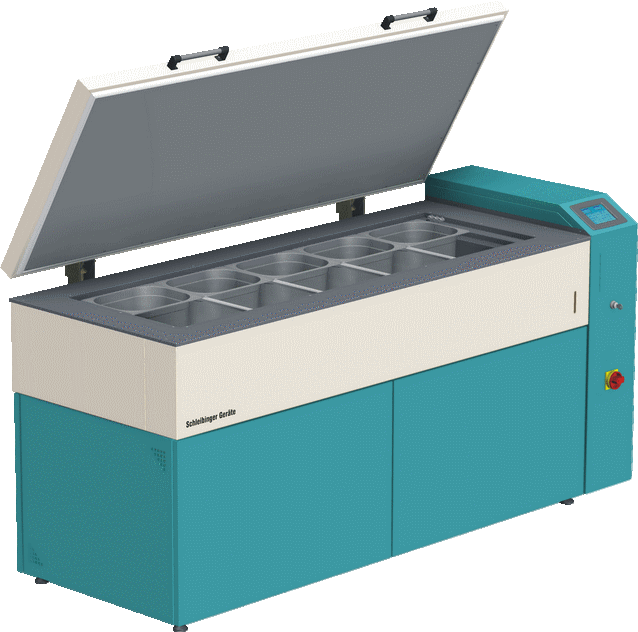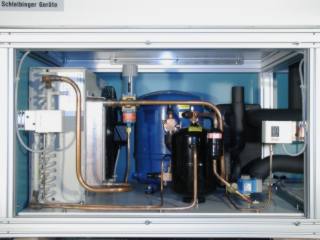

Durability is, beneath the strength, one of the most important properties of concrete. It depends on the type of building and the environmental conditions. it is especially in road construction that a high resistance to freeze-thaw cycles is of major importance and is thus one of the major criteria in testing.The CDF-/CIF test set-up enables the freeze-thaw test to be carried out in accordance with CDF recommendations from RILEM, CEN/TS 12390-9 and CEN/TR 15177 2006-06. The advantage of this test method is in the very good reproducibility of the results that are given. With this test procedure, the weathered quantity of a surface is measured by a number of freeze-thaw cycles. The test specimens are thereby placed in a solution of sodium chloride to stress the surface. The result gives an estimate for the resistance to freeze-thaw cycling for the concrete being tested. The CDF machine fits also the requirements for the ASTM C666-A.
Schleibinger is building the CDF freeze/thaw tester since 1994, The development of this machine is based on a contract with the the inventor of the procedure and machine Prof. M.J. Setzer, University of Essen, Germany. Quality and design was improved continously.
The most important features of the machine:


Preparatory work begins seven days after casting the specimen. The test specimens are stored in a climatic chamber at a temperature of 20 °C and a relative humidity of 65 %. The side faces of the test specimens are sealed five days before the end of dry storage using aluminum foil and butyl adhesive.
Capillary suction commences after the 28th day and continues for seven days, hereby the increase in weight by the test specimens is measured after 2, 3, 4 and 7 days. Capillary suction is then followed by freeze-thaw- cycling in the CDF machine. The quantity thereby weathered is measured after 4, 14 and 28 days.
Also prepared for the following standards :
|
test cab dimensions (WxLxD) |
171 x 51 x 20 cm for 10 container GN-B 1/2 or 15 containers GN-B 1/3 |
|
temperature range |
-20°C to 20 °C |
|
max. temp. deviation |
< 0.5 K |
|
dimensions (LxWxH) |
225 x 95 x 120 cm |
|
required room (LxW) |
350 x 160 cm |
|
power |
6 kW (10.5 kW with ASTM / cube test option) |
|
required fuse |
3 x 25/32 A |
|
weight |
560 kg |
|
environmental conditions |
5 .. 28 °C, max. humidity 65 % |
Technical data may be changed w/o notice.
IDENTIFICATION OF OPTIMAL CONDITION FOR THE DE-ICING SALT SCALING RESISTANCE OF CONCRETE, January 2016, Conference: International RILEM Conference on Materials, Systems and Structures in Civil Engineering
Conference segment on Frost Action At: Lyngby, Denmark, Samindi M.K. Samarakoon, Samdar Kakay, Lieske Tefre, Vikrant Kaushal
International RILEM Conference Materials Systems and Structures in Civil Engineering 2016 (MSSCE 2016) on Frost Action in Concrete, Edited by Marianne Tange Hasholt, Katja Fridh and R. Doug Hooton, ISBN: 978-2-35158-182-7
e-ISBN: 978-2-35158-183-4, Pages: 251, Publication date: 2016
A presentation about the machine and the test procedure
Installation and first setup of the CDF machine